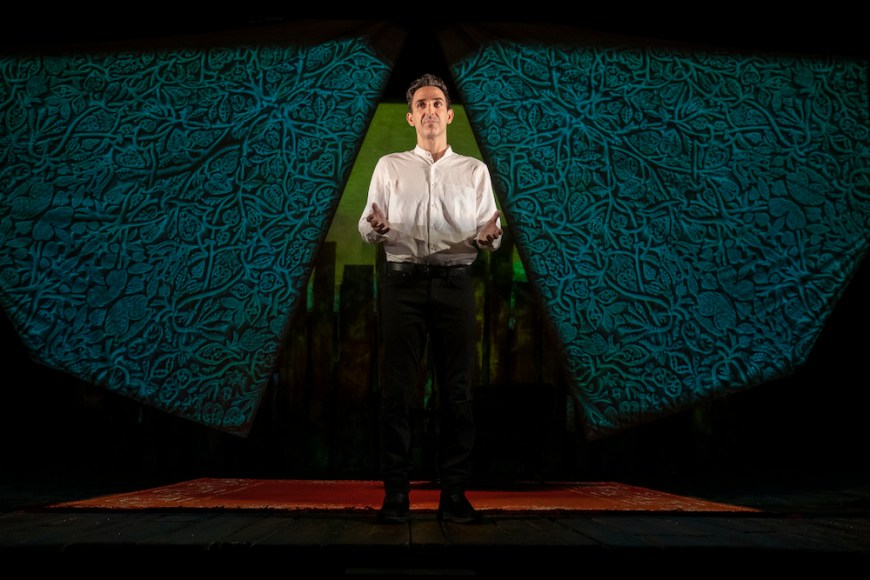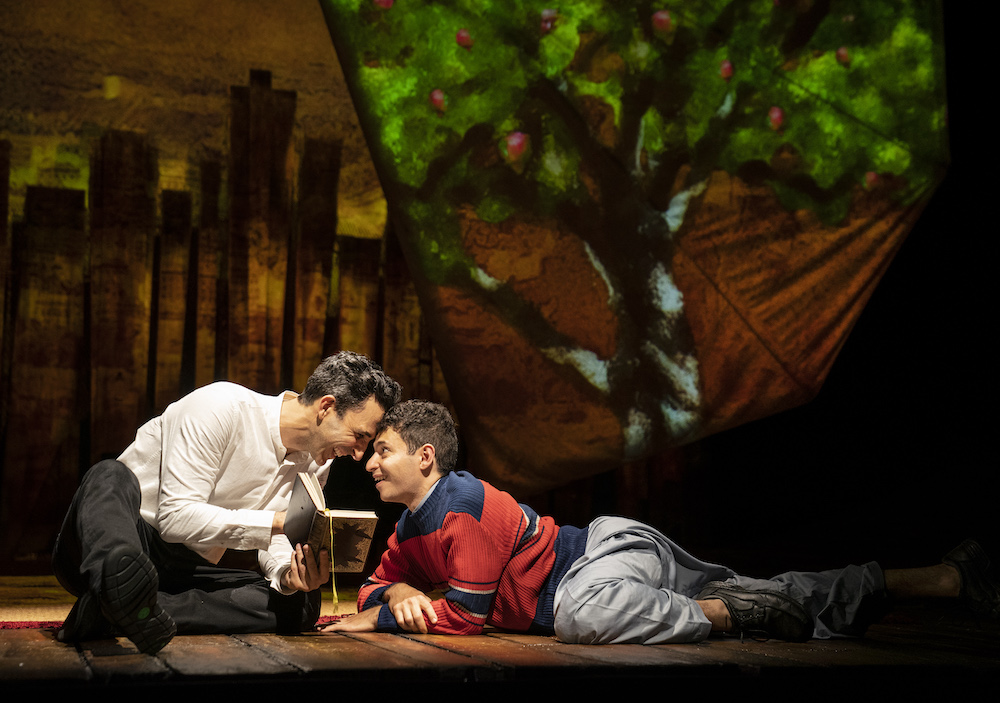
There’s an early sweet and funny scene in “The Kite Runner” that feels like a subconscious warning about how misbegotten this stage adaptation of Khaled Hosseini’s 2003 best-selling novel.
The play, like the novel, is about an immigrant Afghan-American man named Amir (Amir Arison) who tries to make amends as an adult for his betrayal of his best childhood friend, Hassan (Eric Sirakian)
In the scene, Amir eagerly describes to Hassan the first-ever short story that he’s just written: A man discovers a magic cup that turns his tears into pearls. Not normally inclined towards melancholy, the man forces himself to create situations that make him forlorn, so that he’ll produce tears, and then pearls; the story climaxes with the man killing his wife.
“Do you like it?” Amir asks.
“Yes, I do,” the good-natured Hassan replies. “But will you permit me to ask a question?” Why does he have to kill his wife, Hassan asks, or ever feel sad in order to shed tears? Can’t he just use an onion?
Amir looks at Hassan, pauses, and then crumples up his story, which gets a laugh.
The character Amir thus shows more apparent self-awareness than the creative team behind “The Kite Runner,” or the many producers who thought it a good idea to bring to Broadway this tear-jerking page-turner that is so full of eye-rolling and off-putting twists and turns.
Matthew Spangler’s stage adaptation is faithful to a fault – two faults, really. The story hasn’t been sufficiently rethought as a work of theater: Amir Arison performs not just as Amir the adult and Amir the child, but also as Amir the (wordy, stilted) narrator, depriving the other characters of their own breath, and speeding through so many incidents that it’s hard for the audience to catch ours. Spangler also faithfully renders aspects of Hosseini’s novel that I had some qualms about when I read it long ago, which now in (the stage) light of a new era have grown into full-blown objections.




Let’s start with the relationship between Amir and Hassan. They are two motherless boys who are growing up together, spending their days watching John Wayne movies dubbed into Farsi and flying kites. But they are not equal. Hassan is the son of Ali (Evan Zes), who for forty years has been the servant of Amir’s father Baba (Faran Tahir.) Just as Ali is Baba’s servant, so Hassan is Amir’s servant, even though they’re young boys only a year apart. Amir tells us that Ali and his son Hassan are Hazara, a long-persecuted ethnic group of Shi’a Muslims, while Baba and Amir are Pashtuns, Sunni Muslims who form the upper class of the country. The problem for me is that Hassan might as well be a martyred saint – abjectly loyal to Amir, winning kite tournaments for him, protecting him, sacrificing and suffering for him, even while Amir is casually contemptuous of someone he views as his inferior. Hassan is not a fleshed-out character, but a tragic figure (presented from Amir’s perspective.) The set-up reminds me of Harriet Beecher Stowe’s “Uncle Tom’s Cabin,” which in antebellum times was not just a popular entertainment but a work of political advocacy against slavery; it now, however, is widely viewed as pernicious in its sentimental stereotyping. I don’t know whether the treatment of Hassan as a selfless martyr was also originally intended as social advocacy, but in the Hayes Theater on 44th Street in 2022, it comes perilously close to victim porn.

That impression is reinforced by the ugliness of the character Assef (Amir Malaklou in a thankless role), who we first meet as a teenage bully calling Amir and Hassan “Faggot and Fuck Face.” Assef is the unredeemable villain of “The Kite Runner.” He commits the central act of the play (which will be a spoiler for those of you who haven’t read the 2003 novel or seen the 2007 movie, but it would be misleading to talk about the play without mentioning it.) Assef violently rapes Hassan. Amir is a witness and does nothing – which makes him feel so guilty that he plants his gold watch and some cash under Hassan’s mattress, so it will look like Hassan is a thief, and Baba will get rid of him. To protect Amir (in keeping with his saintliness), Hassan falsely confesses to perpetrating the theft.
Amir carries the guilt over these compounded betrayals with him when he and Baba emigrate to America, and it prompts him to return to Afghanistan two decades later — after he gets married and becomes a successful writer — to rescue Hassan’s son Sohrab (also portrayed by Sirakian.) Sohrab, as it turns out, is in the clutches of – guess who? – Assef, who is now not just a leader of the Taliban, but also a pedophile.

The specific details chosen to illustrate Assef’s villainy always disturbed me. It undermined what seemed initially the author’s serious exploration of the downside of the culture of masculinity in Afghan society: Baba is troubled that Amir doesn’t like sports and wants to become a writer, positions that we are made to understand as unenlightened. (“Real men don’t read poetry, and they certainly don’t write it! Real men play soccer, just like I did,” Baba says — an example of the show’s on-the-nose clunky dialogue.) In the past, I tried to reason through the writer’s confusing contradictory choices: “Having the villain rape and abuse boys does not necessarily mean he’s gay, nor that the writer is anti-gay; these are primarily predatory criminal, not homosexual, acts. And what does it mean that Assef called Amir a faggot? It could be, um…” But what seemed then at best an ambiguous mixed message strikes me now, given all that’s happened recently – the increased targeting of LGBT people by the Taliban in Afghanistan, and also by the Republicans in the United States — as outright homophobia, and its inclusion in the stage version worse than regrettable.
I feel somewhat similarly about what at first glance might seem to be one of the best things about the play — its use of Afghan history and culture. They’ve even hired a “cultural adviser and script consultant,” Humaira Ghilzai, “to ensure authenticity in all aspects of the production.” There are a few lines about the political changes and challenges in the country as we follow Amir’s saga over roughly a quarter of a century starting in around 1975; we hear of the end of Afghanistan’s monarchy, the Soviet invasion, and then the Taliban regime. But these start to feel almost insulting in their superficiality, in service to a story that at its best has the tone of a folk tale, but detours with some frequency into pulpy melodrama. The story allows little room for, nor exhibits much interest in, the complexity of the country’s history. (Here is PBS’s A Historical Timeline of Afghanistan, from 1921 to 2021.)
“The Kite Runner” was a novelty when it was published not long after 9/11, by a writer who grew up in Afghanistan no less. But the theatrical landscape in New York is not the same as the literary one in America two decades ago, as I detailed in my review last year of “Selling Kabul,” a play by Sylvia Khoury that takes place in Afghanistan and was a finalist for the Pulitzer Prize in Drama. A marathon theatrical event in 2010 entitled “The Great Game: Afghanistan,” a full day of short new plays by various established playwrights (19 works in all!), dramatized the history of the country and its relationship with foreign powers from 1842 to 2010 — and demonstrated how It is possible for theater about Afghanistan to be dramatic, factual and illuminating. J.T. Rogers’ play “Blood and Gifts” debuted the following year. Then “The Boy Who Danced on Air” in 2017 demonstrated how it’s also possible for theater about Afghanistan to be overly dramatic, dubiously factual, and unilluminating. (It is worth noting that this musical was about an illegal revival of an ancient tradition called Bacha Bazi, literally “boy play,” in which rich people buy boys to be sex slaves and train them to be dancers — which is clearly what’s going on with Assef; we see him making Sohrab dance.) In October of last year, LA Writers Center put together “The Voices of Afghanistan,”a videotaped “verbatim theater piece” based on interviews with Afghan and Afghan-American citizens, that is available on HowlRound.

Under Giles Croft’s direction, “The Kite Runner” is professionally acted by an appealing cast of 12, all but two of whom are making their Broadway debuts. The design is efficient, as if geared for touring — projections of childlike drawings of city skylines in Kabul and San Francisco; Asian carpets, an intricately decorated curtain that seemed to be in the shape of a kite. A highlight of the production is the music; Salar Nader sits on stage throughout all two and a half hours, playing the tabla, the traditional twin hand drums of Hindustani classical music. Wouldn’t it have been better to have employed all this talent for an original work of theater that had something new and nuanced to say?






The Kite Runner
Hayes Theater through October 30, 2022
Running time: Two and a half hours including intermission
Tickets: $69-$199
Adapted by Matthew Spangler; Based on the Novel by Khaled Hosseini;
Directed by Giles Croft;
Composer and musical supervisor: Jonathan Girling
Scenic and costume design by Barney George, Lighting Design by Charles Balfour; Sound Design by Drew Baumohl; Projection Design by William Simpson
Cast: Amir Arison as Amir, Faran Tahir as Baba, Eric Sirakian as Hassan and Sohrab, Mazin Akar, Barzin Akhavan, Demosthenes Chrysan, Azita Ghanizada, Danish Farooqui, Joe Joseph, Déa Julien, Dariush Kashani, Beejan Land, Amir Malaklou, Christine Mirzayan, Haris Pervaiz, Alex Purcell, Houshang Touzie, and Evan Zes. Salar Nader plays the tabla, a percussion instrument.
